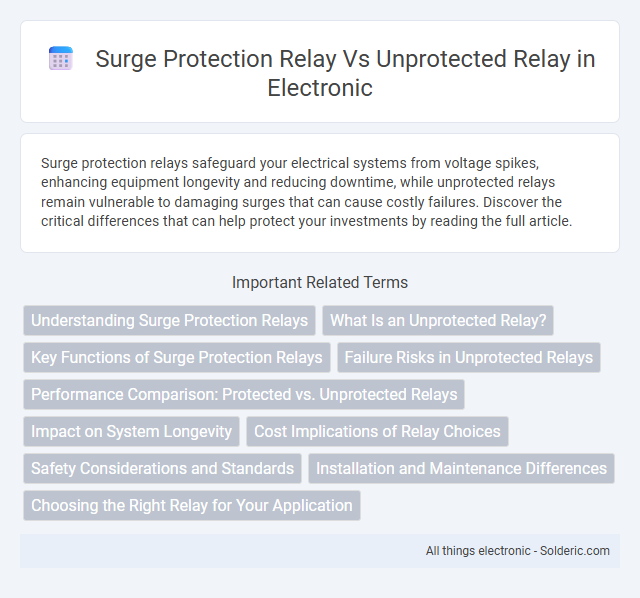Surge protection relays safeguard your electrical systems from voltage spikes, enhancing equipment longevity and reducing downtime, while unprotected relays remain vulnerable to damaging surges that can cause costly failures. Discover the critical differences that can help protect your investments by reading the full article.
Comparison Table
| Feature | Surge Protection Relay | Unprotected Relay |
|---|---|---|
| Primary Function | Protects electrical systems from voltage surges and transient spikes | Performs standard switching without surge defense |
| Damage Risk | Minimized due to built-in surge suppression | High risk during voltage spikes and surges |
| Lifespan | Extended due to protection against electrical stress | Reduced due to vulnerability to electrical surges |
| Cost | Higher initial investment | Lower upfront cost |
| Maintenance | Lower frequency due to reduced damage | Higher maintenance required to fix surge-related failures |
| Application | Critical electrical systems requiring surge defense | Non-critical systems or where cost is a constraint |
Understanding Surge Protection Relays
Surge protection relays safeguard electrical systems by detecting and isolating voltage spikes to prevent equipment damage, whereas unprotected relays lack this voltage spike monitoring capability. These relays utilize advanced sensors and algorithms to respond instantly to transient overvoltages, ensuring enhanced reliability and longevity of electrical components. Implementing surge protection relays reduces downtime and maintenance costs by mitigating the risks associated with electrical surges and transient events.
What Is an Unprotected Relay?
An unprotected relay operates without any built-in mechanisms to guard against voltage spikes, electrical surges, or transient faults, increasing the risk of relay damage and system failure. Surge protection relays incorporate specialized components such as metal oxide varistors (MOVs) or gas discharge tubes (GDTs) to absorb and divert excess energy, enhancing operational reliability and prolonging equipment life. Choosing surge protection relays prevents costly downtime, improves system stability, and reduces maintenance expenses compared to unprotected relay installations.
Key Functions of Surge Protection Relays
Surge protection relays safeguard electrical systems by detecting overvoltage spikes and quickly isolating equipment to prevent damage, whereas unprotected relays offer no defense against surges. Key functions of surge protection relays include real-time surge detection, fault signal transmission, and coordinated tripping to maintain system stability. Protecting your equipment with a surge protection relay ensures enhanced reliability and reduces the risk of costly downtime caused by transient voltage surges.
Failure Risks in Unprotected Relays
Unprotected relays are highly susceptible to failure risks such as severe damage from electrical surges, voltage spikes, and transient overvoltages that can lead to system malfunctions or complete outages. Surge protection relays, equipped with advanced sensors and rapid response mechanisms, safeguard your electrical equipment by detecting and mitigating these harmful surges effectively. Using surge protection relays significantly enhances the longevity and reliability of your electrical infrastructure by reducing the chances of relay failure and costly downtime.
Performance Comparison: Protected vs. Unprotected Relays
Surge protection relays offer superior performance by safeguarding electrical systems against voltage spikes, reducing equipment damage and downtime, unlike unprotected relays that are vulnerable to power surges and transient overvoltages. Your system's reliability improves significantly with surge protection relays, as they ensure continuous operation and longevity by interrupting abnormal voltage conditions effectively. In contrast, unprotected relays often fail prematurely, leading to costly replacements and maintenance.
Impact on System Longevity
Surge protection relays significantly enhance system longevity by shielding electrical components from voltage spikes and transient surges that cause premature wear and failure. Unprotected relays are susceptible to damage from these surges, leading to frequent maintenance and reduced operational lifespan. Investing in a surge protection relay safeguards your system's reliability and extends its functional life, minimizing downtime and replacement costs.
Cost Implications of Relay Choices
Surge protection relays generally incur higher initial costs compared to unprotected relays due to integrated protective components that safeguard electrical systems from transient voltage spikes. Unprotected relays may reduce upfront expenses but often lead to increased maintenance, downtime, and equipment replacement costs caused by damage from surges. Investing in surge protection relays ultimately minimizes long-term operational expenses and enhances system reliability, making them a cost-effective solution despite the higher purchase price.
Safety Considerations and Standards
Surge Protection Relays are designed to safeguard electrical systems by detecting and mitigating transient voltage spikes, significantly enhancing safety by preventing equipment damage and fire hazards. Unprotected Relays lack this safeguard, increasing the risk of failure and safety incidents due to surges. Ensuring your system complies with standards such as IEC 60255 and IEEE C37.90 guarantees reliable protection and operational safety under surge conditions.
Installation and Maintenance Differences
Surge protection relays require specialized installation involving surge arresters and grounding systems to safeguard equipment from voltage spikes, whereas unprotected relays have simpler wiring but lack such defense mechanisms. Maintenance for surge protection relays includes regular inspection of surge components and monitoring for degradation caused by transient events, contrasting with unprotected relays that need routine checks primarily for mechanical and electrical contact integrity. Your choice impacts long-term operational reliability, with surge protection relays reducing downtime and repair costs due to better resilience against electrical surges.
Choosing the Right Relay for Your Application
Choosing the right relay for your application hinges on understanding the critical differences between surge protection relays and unprotected relays. Surge protection relays safeguard sensitive equipment by automatically disconnecting circuits during voltage spikes, thereby preventing damage and prolonging device lifespan. Unprotected relays lack these features, exposing your system to potential failures and costly downtime in environments prone to electrical surges.
Surge Protection Relay vs Unprotected Relay Infographic

 solderic.com
solderic.com